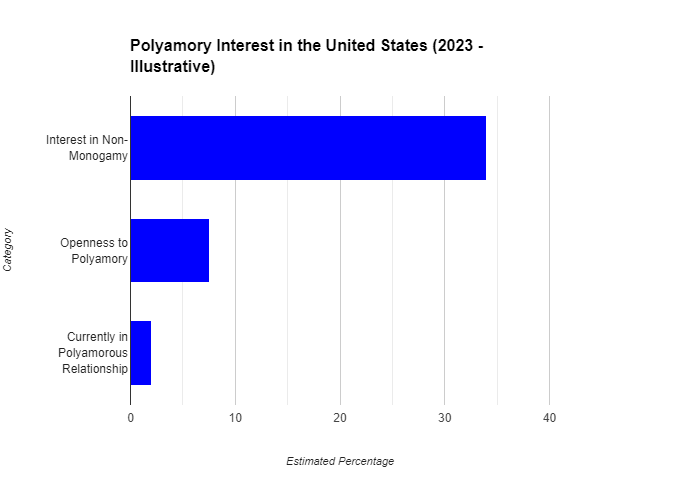
Have a Seat at the Table
Open relationships have been gaining traction in recent years, challenging traditional notions of monogamy. Among the various relationship styles, kitchen table polyamory stands out as a unique approach that emphasizes community, transparency, and interconnectedness. In this post, we’ll look at the details of kitchen table polyamory, exploring its origins, principles, and practical applications.
So What is Kitchen Table Polyamory?
Kitchen table polyamory refers to a style of polyamorous relationship where all partners, including metamours (partners’ partners), are comfortable interacting with each other.
The name originates from the idea that everyone in the relationship dynamic could gather around a kitchen table and share a meal, fostering open communication and camaraderie.
Origins of Kitchen Table Polyamory
The concept of kitchen table polyamory emerged from the polyamorous community as a response to the challenges of navigating multiple relationships.
It emphasizes the importance of building connections not just with primary partners but also with their partners’ partners, creating a sense of family and community within the polycule.
Why Kitchen Table Polyamory Matters
Kitchen table polyamory offers a refreshing alternative to traditional relationship structures, promoting inclusivity, honesty, and mutual respect.
By prioritizing open communication and building strong interpersonal connections, it provides a framework for helping with the complexities of polyamorous relationships with grace and authenticity.
Understanding Polyamory

Defining Polyamory
Polyamory is the practice of engaging in multiple romantic or sexual relationships simultaneously with the consent of all parties involved.
Unlike monogamy, which is based on exclusivity, polyamory embraces the idea that love and intimacy are not finite resources and can be shared among multiple partners.
Different Forms of Polyamorous Relationships
Polyamorous relationships come in various forms, ranging from hierarchical structures with primary and secondary partners to non-hierarchical arrangements where all partners are considered equal. Kitchen table polyamory falls into the latter category.
Various types of Polyamorous styles:
-
Hierarchical Polyamory: In hierarchical polyamory, partners are ranked in a hierarchy, with one or more primary partners who hold priority over secondary or tertiary partners.
-
Non-Hierarchical Polyamory: Non-hierarchical polyamory emphasizes equality among all partners, with no designated primary or secondary roles.
-
Solo Polyamory: Solo polyamory refers to individuals who prioritize their autonomy and independence, maintaining multiple relationships without necessarily seeking a primary partner or nesting partner.
-
Relationship Anarchy: Relationship anarchy challenges traditional relationship hierarchies and structures, advocating for autonomy, consent, and the freedom to define relationships on one’s own terms.
-
Parallel Polyamory: Parallel polyamory involves partners maintaining separate relationships with little to no interaction between metamours.
-
Polyfidelity: Polyfidelity refers to a closed group of partners who are sexually and emotionally exclusive within the group, similar to monogamy but with multiple partners.
-
Swinging: Swinging involves couples engaging in consensual non-monogamous sexual activities with other couples or individuals for recreational purposes, often without emotional involvement.
-
Triads and Quads: Triads consist of three individuals forming a romantic relationship together, while quads involve four individuals forming a romantic or sexual relationship together.
-
Polycules: Polycules are complex networks of interconnected relationships involving multiple partners, metamours, and extended networks of connections.
-
Relationship Escalator: The relationship escalator refers to the societal expectation of progressing through predetermined stages in a monogamous relationship, such as dating, moving in together, getting married, and having children. Polyamorous individuals may reject or redefine these expectations in favour of more fluid and customizable relationship structures.
-
Anarchist Polyamory: Anarchist polyamory rejects hierarchical structures and emphasizes autonomy, consent, and individual agency in defining and navigating relationships.
-
Vee Relationship: A vee relationship involves one individual (the hinge) having two separate relationships with two other individuals (the arms), who may or may not have a relationship with each other.
-
Triads and N+1 Relationships: Triads involve three individuals forming a romantic or sexual relationship together, while N+1 relationships involve adding additional partners to an existing relationship dynamic.
5 Benefits of Polyamory
-
Emotional Support: Polyamory allows individuals to receive emotional support from multiple partners, fostering a sense of belonging, intimacy, and connection within a supportive network of relationships.
-
Diverse Experiences: Polyamory offers the opportunity to explore diverse experiences and connections with different partners, enriching one’s life with a variety of perspectives, interests, and activities.
-
Personal Growth: Engaging in polyamorous relationships can promote personal growth and self-awareness, as individuals navigate complex emotions, communication challenges, and relationship dynamics, fostering greater introspection and resilience.
-
Increased Intimacy: Polyamory encourages open communication, vulnerability, and authenticity, leading to deeper emotional connections and intimacy with partners, as individuals share their thoughts, feelings, and desires openly and honestly.
-
Relationship Flexibility: Polyamory provides flexibility in relationship structures and dynamics, allowing individuals to customize their relationships based on their needs, preferences, and values, whether they prioritize autonomy, egalitarianism, or hierarchical structures.
Exploring Open Relationships
What are Open Relationships?
Open relationships are characterized by the willingness to engage in romantic or sexual interactions outside of traditional monogamous boundaries.
Unlike polyamory, which involves maintaining multiple ongoing relationships, open relationships may involve casual encounters or occasional flings with other individuals.

Types of Open Relationships
Open relationships can take many forms, from sexually open partnerships where partners are free to pursue physical intimacy with others to emotionally open arrangements where partners may form deep emotional connections with multiple people.
Each type of open relationship comes with its own set of challenges and rewards.
Pros and Cons of Open Relationships
Open relationships offer the opportunity for increased sexual exploration, personal growth, and relationship flexibility. However, they also require a high level of trust, communication, and emotional maturity to work successfully.
Understanding the pros and cons is essential for anyone considering entering into an open relationship.
Key Components of Kitchen Table Polyamory
Key components of kitchen table polyamory include building strong interpersonal connections, fostering a sense of community, and prioritizing the well-being of all partners involved.
By creating a supportive and inclusive environment, kitchen table polyamory promotes emotional intimacy and personal growth.
Building a Kitchen Table Polyamorous Relationship
Finding Compatible Partners
To find the right partners in a kitchen table polyamorous setup, it’s all about chatting openly, being real, and staying open to new connections.
Everyone must vibe on the same wavelength, sharing similar values, goals, and relationship hopes. That’s what builds that sweet compatibility and mutual understanding.
Establishing Communication Guidelines
Effective communication forms the cornerstone of successful polyamorous relationships, and in the unique context of kitchen table polyamory, it takes on even greater significance.
Partners in kitchen table polyamory must establish robust communication guidelines to ensure that everyone’s needs, desires, and boundaries are understood and respected within the relationship dynamic.
Setting up clear communication protocols involves laying down the groundwork for how information is shared, conflicts are addressed, and individual voices are heard and valued.
This might entail regular check-ins, open and honest dialogue, and a commitment to active listening and empathy.
In addition to discussing logistical matters, such as scheduling and boundaries, partners should also create space for emotional communication, allowing each other to express feelings, concerns, and desires openly and without judgment.
This fosters a culture of trust, vulnerability, and mutual support within the polycule.
Setting Boundaries and Expectations
Setting boundaries and expectations is crucial for maintaining healthy and sustainable relationships in a kitchen table polyamorous dynamic.
Partners should discuss their boundaries and negotiate agreements that respect everyone’s needs and desires, ensuring that all parties feel valued and respected.
Jealousy and Insecurities
Understanding Jealousy in Polyamory
Jealousy is a natural and common emotion in polyamorous relationships, but it can also be a source of tension and conflict if not addressed effectively.
Understanding the root causes of jealousy and learning how to manage it can help partners navigate the complexities of polyamory with greater ease and compassion.
Strategies for Managing Jealousy
There are various strategies for managing jealousy in polyamorous relationships, including practising self-awareness, fostering trust and transparency, and cultivating compersion—the ability to experience joy in your partner’s happiness with others.
By addressing jealousy head-on and communicating openly about their feelings, partners can strengthen their bonds and deepen their connections.
Honouring Emotions and Feelings
In kitchen table polyamory, it’s essential to honour and validate each partner’s emotions and feelings, even when they are difficult or uncomfortable.
try to create a safe space for expressing vulnerability and practising empathy, fostering a culture of emotional honesty and mutual support within the polycule.
Creating a Supportive Polycule
Fostering Trust and Transparency
Trust and transparency are the foundation of any healthy polyamorous relationship, but they are especially important in kitchen table polyamory.
Prioritize open communication, honesty, and integrity, creating a culture of trust and accountability within the polycule.
Building Strong Metamour Relationships
Building strong metamour relationships is essential for creating a supportive and inclusive polycule.
Maybe invest time and effort into getting to know each other, fostering friendships, and building connections based on mutual respect and understanding.
Creating a Sense of Community
Creating a sense of community within the relationship can enhance feelings of belonging and connection among all partners involved.
Try getting involved in group activities, celebrate milestones together, and support each other through life’s ups and downs, fostering a culture of camaraderie and support within the kitchen table polyamorous dynamic.
Communication in Kitchen Table Polyamory
Effective Communication Techniques
Effective communication is the cornerstone of kitchen table polyamory, enabling partners to express their needs, desires, and boundaries openly and honestly.
Practice active listening, empathy, and nonviolent communication techniques, fostering a culture of understanding and mutual respect within the polycule.
Handling Conflict and Disagreements
Conflict is inevitable in any relationship, but it’s how partners handle conflict that determines the health and longevity of the relationship.
In kitchen table polyamory, partners should approach conflict with empathy, patience, and a willingness to compromise, seeking mutually beneficial solutions that honour everyone’s needs and desires.
Cultivating Empathy and Understanding
Cultivating empathy and understanding is essential for fostering meaningful connections and resolving conflicts in kitchen table polyamory.
Always strive to see things from each other’s perspectives as they would in any relationship, validate each other’s experiences, and practice compassion and forgiveness, creating a culture of empathy and understanding within the polycule.
Practical Tips for Success

Balancing Time and Attention
Balancing time and attention among multiple partners can be challenging in polyamorous relationships, but it’s essential for maintaining harmony and balance within the polycule. It’s not like you can have set days for each partner, after all this is a relationship.
Time is everything prioritizing quality time with each other is essential, communicating openly about their needs and desires, and seeking creative solutions for managing their schedules effectively.
Managing Logistics in a Polycule
Managing logistics in a polycule requires careful planning, and coordination among all partners involved.
Discuss practical considerations such as living arrangements, financial responsibilities, and childcare arrangements, ensuring that everyone’s needs and preferences are taken into account.
Self-Care and Personal Growth
Self-care and personal growth are essential for maintaining individual well-being and fulfilment in polyamorous relationships.
Partners should prioritize their physical, emotional, and mental health, engage in activities that bring them joy and fulfilment, and invest in personal development and growth, fostering a culture of self-awareness and empowerment within the polycule.
Challenges and Pitfalls
Common Challenges in Kitchen Table Polyamory
Despite its many benefits, kitchen table polyamory comes with its own set of challenges and pitfalls.
Jealousy may creep in, insecurity, and communication breakdowns, requiring patience, empathy, and a willingness to work through difficult emotions together.
Addressing Power Dynamics
Addressing power dynamics is essential for maintaining balance and equality within a kitchen table polyamorous dynamic.
Be mindful of any imbalances of power or privilege and work to ensure that everyone’s voices are heard, needs are met, and contributions are valued within the polycule.
Dealing with External Judgments
Handling external judgments and societal stigma can be challenging for individuals in polyamorous relationships, especially those practising kitchen table polyamory.
Try to develop coping strategies for dealing with judgmental attitudes, educate others about the benefits of polyamory, and seek support from like-minded communities and allies.
Maintaining Privacy and Discretion
Privacy Considerations in Polyamorous Relationships
Maintaining privacy and discretion is essential for protecting the well-being and confidentiality of all partners involved in a polyamorous relationship.
Discuss comfort levels with disclosure, establish clear boundaries around privacy and confidentiality, and communicate openly about their needs and preferences regarding discretion.
Dealing with Social Stigma

Navigating social stigma and judgment can be challenging for individuals in polyamorous relationships, who may face discrimination, prejudice, and misconceptions from friends, family, and society at large.
Educating others about polyamory, seeking support from like-minded communities, and advocating for greater acceptance and understanding can all help with dealing with the social stigma.
Resources and Support
Online Communities and Forums
Online communities and forums provide valuable resources, support, and camaraderie for individuals in polyamorous relationships.
Partners can connect with like-minded individuals, share experiences and advice, and find community and belonging within the polyamorous community.
Books and Literature on Polyamory
Books and literature on polyamory offer valuable insights, perspectives, and practical advice for individuals navigating polyamorous relationships.
Here are a selection of our reads and recommendations
-
The Ethical Slut: A Practical Guide to Polyamory, Open Relationships & Other Adventures by Janet W. Hardy and Dossie Easton Considered a classic in the polyamory community, this book covers a wide range of topics related to non-monogamy, from communication and jealousy to relationship structures and navigating social stigma.
Ethical Slut: A Practical Guide to Polyamory, Open Relationships & Other Adventures by Janet W. Hardy and Dossie Easton -
More Than Two: A Practical Guide to Ethical Polyamory by Franklin Veaux and Eve Rickert This book offers a practical and accessible guide to navigating polyamorous relationships. It covers topics such as communication, jealousy, boundaries, and ethical considerations.
More Than Two: A Practical Guide to Ethical Polyamory by Franklin Veaux and Eve Rickert -
Polysecure: Attachment, Trauma and Consensual Non-Monogamy by Jessica Fern This book combines principles of attachment theory and trauma-informed care with polyamory. It helps readers understand how their attachment styles may influence their experiences in polyamorous relationships.
Polysecure: Attachment, Trauma and Consensual NonMonogamy by Jessica Fern -
Opening Up: A Guide to Creating and Sustaining Open Relationships by Tristan Taormino This book is a well-respected guide to opening up a monogamous relationship. It provides guidance on communication, boundaries, and navigating jealousy.
Opening Up: A Guide to Creating and Sustaining Open Relationships by Tristan Taormino -
The Anxious Person’s Guide to Non-Monogamy by Lola Phoenix This book is a great resource for people who are considering non-monogamy but are worried about feeling anxious or jealous. It provides practical tips for managing anxiety and building secure and fulfilling relationships.
Anxious Person’s Guide to NonMonogamy by Lola Phoenix
Finding Local Polyamory Groups
Finding local polyamory groups and meetups can provide opportunities for socializing, networking, and building community with other polyamorous individuals.
Polyamory groups can be found through various avenues, both online and offline, offering opportunities for individuals to connect, share experiences, and build community with like-minded individuals.
Here are some places where you can find polyamory groups:
-
Online Communities and Forums: Websites like Reddit (r/polyamory), Facebook groups, and dedicated polyamory forums offer spaces for individuals to connect with others who are practising or interested in polyamory. These platforms allow for discussions, advice-sharing, and networking with a diverse community of polyamorous individuals.
-
Meetup.com: Meetup.com often hosts local polyamory groups and events in different cities around the world. You can search for polyamory-related meetups in your area, ranging from discussion groups and social gatherings to workshops and support groups.
-
Polyamory Conferences and Events: Polyamory conferences, festivals, and events are held in various locations throughout the year, bringing together polyamorous individuals, experts, and advocates for networking, education, and community-building. Websites like Poly Dallas Millennium and Loving More provide information on upcoming events and gatherings.
-
Local LGBTQ+ Centers: Many LGBTQ+ community centres and organizations host polyamory discussion groups, support groups, and social events as part of their programming. Check with your local centre to see if they offer any polyamory-related resources or events.
-
Polyamory Meetup Groups: Some cities have dedicated polyamory meetup groups that organize regular gatherings, social events, and discussions for polyamorous individuals and their allies. These groups often provide a welcoming and inclusive space for people to connect and share experiences.
-
Online Dating Platforms: Some online dating platforms, such as OkCupid and Feeld, allow users to identify as polyamorous and search for partners who are open to non-monogamous relationships. You can use these platforms to connect with other polyamorous individuals in your area or beyond.
-
Local Polyamory Organizations: In some regions, there may be local polyamory organizations or support groups that offer resources, events, and community-building opportunities for polyamorous individuals and their partners. These organizations may have websites or social media pages where you can learn more about their activities and how to get involved.
By exploring these avenues, you can find polyamory groups and communities where you can connect with others, share experiences, and find support on your polyamorous journey.
Conclusion
In conclusion, kitchen table polyamory offers a unique and inclusive approach to open relationships, emphasizing community, transparency, and mutual respect.
By prioritizing open communication, building strong interpersonal connections, and fostering a sense of belonging within the polycule, partners can create fulfilling and meaningful relationships that honour their individual needs and desires.
Whether you’re new to polyamory or a seasoned practitioner, embracing the principles of kitchen table polyamory can lead to greater understanding, fulfilment, and connection in your relationships.
Are you in a kitchen table polyamorous relationship or see yourself in one let us know in the comments your views.


